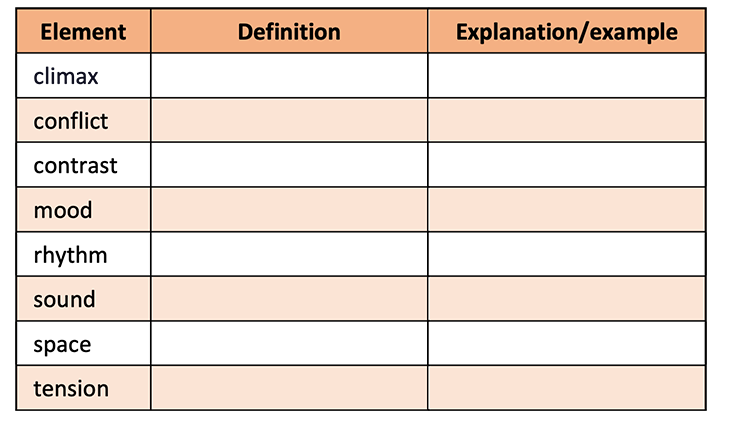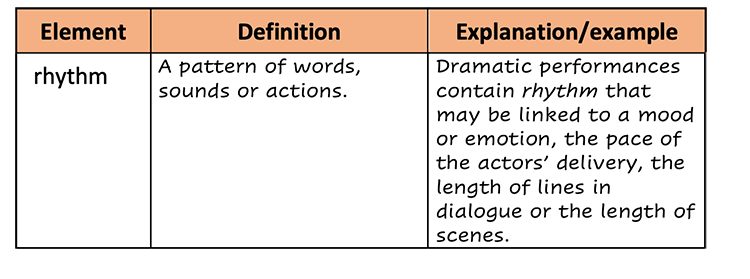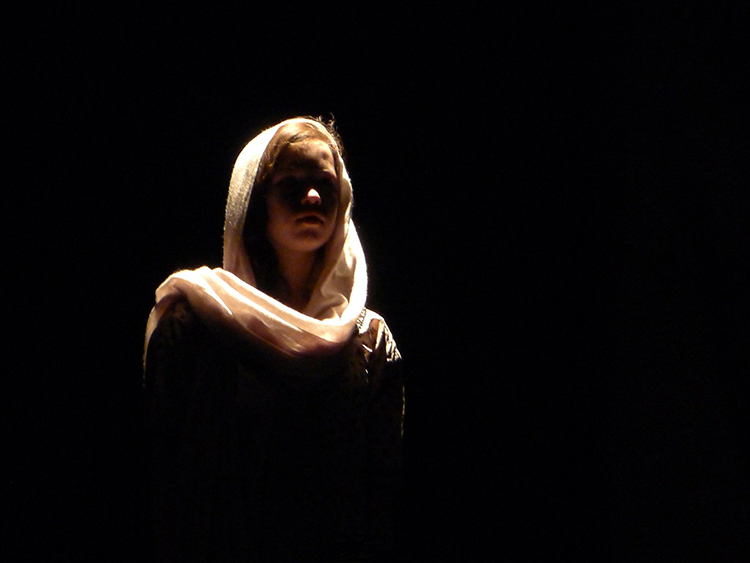Drama specific language is conceptual and performative (Nicholson, 2010). In addition to teaching vocabulary through writing, physical activities may support students’ acquisition of language in Drama. Two strategies to support students’ development of vocabulary in Drama are
- Creating and using drama glossaries
- Learning and revising language through games.
Teachers may also wish to look at the vocabulary-building strategy ‘Connecting verbal language and movement’ in the Dance section of the toolkit.
Creating and using Drama glossaries
The following strategy is designed to introduce students to Drama-specific vocabulary. It may also be used as a revision strategy for students with prior experience in using the language of Drama elements.
- The teacher poses questions to the students:
- ‘What does element mean?
- ‘Where else have you heard that word?’
- ‘Do you use it in other subjects, for example, Science?’
- Teacher and students discuss the use of the term ‘element’ in different contexts.
- Definitions are discussed, for example, ‘An essential part or component of something.’
- The teacher emphasises the importance of learning and using the language associated with dramatic elements as they are essential to understanding in Drama.
- The teacher presents students with a definition of element in the Drama context. For example,
“Dramatic elements are essential features of every performance. Actors manipulate dramatic elements to shape and enhance meaning.” (MTC, n.d., n.p.)
- The teacher presents students with a list or table of dramatic elements, such as that below.

- The teacher gives the students a few minutes to draw on their existing knowledge and discuss in pairs
- words from the list that they recognise
- where they have seen or used the words
- what the words might refer to in Drama.
- The teacher draws all pairs into a class discussion about other subjects or contexts in which the students may have used these words. For example, ‘climax’ when studying a novel or writing a narrative: ‘rhythm’ when playing a musical instrument.
- The teacher models a definition and an explanation of one of the terms used in Drama. An example is provided in the table below.

- The teacher presents jumbled definitions and explanations associated with each element via PowerPoint or via cards/handouts. A list of
definitions of Dramatic Elements can be found on
the Melbourne Theatre Company website. The
‘elements of drama’ are also listed in
the ACARA Arts glossary. Individual entries exist for each element
- In their pairs, students discuss the matching of definitions to each element and complete the columns in the table.
- The students and the teacher discuss the matching activity and definitions.
- The teacher leads a discussion during which students link relevant elements from their glossaries to visual, audio or video representations.
- As an example, the teacher might supply the following prompts in relation to the image below.
- What dramatic elements are represented in the image below? (for example, mood)?
- Brainstorm some adjectives to describe the scene.
- Drawing on your ideas and glossaries, create a description of the image (for example, ‘The dramatic element of mood is created through low key lighting, which draws attention to the woman. The mood is one of isolation and vulnerability, represented by the dark background and shadows over the performer’s face.).

- Students work in pairs to write sentences using the language from their glossaries to describe the representations.
- Students share their descriptions.
- The descriptions may be displayed around the room alongside dramatic elements vocabulary and images.
Curriculum links for the above example:
VCADRE033,
VCADRD035,
VCADRR039,
VCADRE040,
VCADRD042,
VCADRR046.
Learning and revising language through games
The acquisition, understanding and use of discipline-specific vocabulary is crucial in Drama. As Drama draws on students’ collaborative, physical and performative skills, team-based games may support the building and the revising of language in Drama.
In the following strategy, students work together to recall, articulate, refine, and supply feedback on specific language. This collaborative strategy provides a low risk and engaging approach to using Drama-specific language and scaffolds the students to explore and apply the language in performance-based activities. Joint construction and use of peer feedback support students to refine their definitions.
- The teacher uses a mixture of familiar and new vocabulary, including
the language of the dramatic elements.
- The teacher allocates students into teams of 5 or 6 students.
-
Each team stands in a line at one end of the room. Some pencils and an eraser are placed near each team.
- Two containers per group are found at the other end of the room. One container holds slips of paper with a word/phrase written on them. These will be a mixture of known and new drama language and/or words relevant to the lesson and upcoming unit, for example, ‘heightened language,’ ‘tableau,’ ‘conflict,’ ‘status.’ The other box is empty.
- When the teacher calls ‘Go,’ one student from each team runs and takes a slip of paper from their team’s container at the other end of the room.
- The student runs back to their team and touches the next team member’s hand. The second student then runs to retrieve another slip of paper at the other end of the room. Only one person at a time can be running to the other end of the room.
- Back in their teams, students discuss quietly (so other teams cannot hear) and write a brief definition of the word on the slip of paper.
- In turn, each student returns their completed definition to their group’s empty container at the other end of the room, and at the same time takes another slip of paper with a novel word/phrase.
- This process is repeated until all words have been defined.
- When a group completes all definitions and returns them to their container at the other end of the room, the team sits down with their hands on their heads to show they are finished.
- Teams swap their containers of definitions for peer scoring.
- The teacher asks students to read the written definitions.
- The teacher and students discuss the groups’ definitions and give points based on their accuracy.
-
Students are encouraged to record precise definitions in their Drama glossaries.
- The game may be repeated across lessons and units to introduce unfamiliar words or as a form of revision.
Curriculum links for the above example:
VCADRE034,
VCADRD035,
VCADRD036,
VCADRD042.